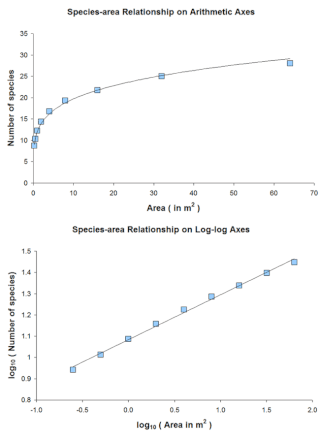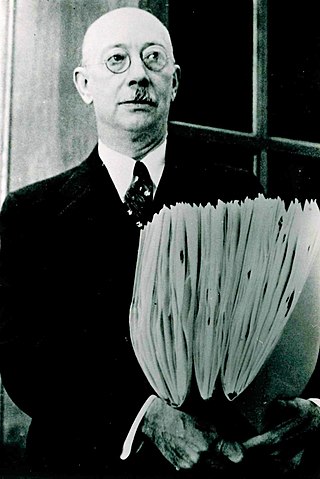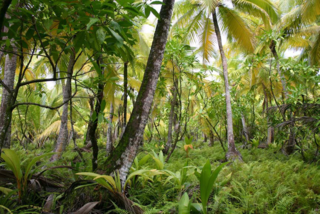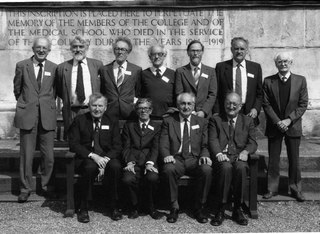
A biocenosis, coined by Karl Möbius in 1877, describes the interacting organisms living together in a habitat (biotope). The use of this term has declined in the 21st сentury.

In scientific ecology, climax community or climatic climax community is a historic term for a community of plants, animals, and fungi which, through the process of ecological succession in the development of vegetation in an area over time, have reached a steady state. This equilibrium was thought to occur because the climax community is composed of species best adapted to average conditions in that area. The term is sometimes also applied in soil development. Nevertheless, it has been found that a "steady state" is more apparent than real, particularly across long timescales. Notwithstanding, it remains a useful concept.

Ecological succession is the process of change in the species that make up an ecological community over time.

Sir Arthur George Tansley FLS, FRS was an English botanist and a pioneer in the science of ecology.
Ecotopes are the smallest ecologically distinct landscape features in a landscape mapping and classification system. As such, they represent relatively homogeneous, spatially explicit landscape functional units that are useful for stratifying landscapes into ecologically distinct features for the measurement and mapping of landscape structure, function and change.
Ecology is a new science and considered as an important branch of biological science, having only become prominent during the second half of the 20th century. Ecological thought is derivative of established currents in philosophy, particularly from ethics and politics.

The British Ecological Society is a learned society in the field of ecology that was founded in 1913. It is the oldest ecological society in the world. The Society's original objective was "to promote and foster the study of Ecology in its widest sense" and this remains the central theme guiding its activities today. The Society had, circa 2024 around 7,000 members of which 14% are students. Of its members, 42% are outside the United Kingdom, in a total of 92 countries. The head office is located in London.
Spatial ecology studies the ultimate distributional or spatial unit occupied by a species. In a particular habitat shared by several species, each of the species is usually confined to its own microhabitat or spatial niche because two species in the same general territory cannot usually occupy the same ecological niche for any significant length of time.

The species–area relationship or species–area curve describes the relationship between the area of a habitat, or of part of a habitat, and the number of species found within that area. Larger areas tend to contain larger numbers of species, and empirically, the relative numbers seem to follow systematic mathematical relationships. The species–area relationship is usually constructed for a single type of organism, such as all vascular plants or all species of a specific trophic level within a particular site. It is rarely if ever, constructed for all types of organisms if simply because of the prodigious data requirements. It is related but not identical to the species discovery curve.
Frederic Edward Clements was an American plant ecologist and pioneer in the study of plant ecology and vegetation succession.
Phytosociology, also known as phytocoenology or simply plant sociology, is the study of groups of species of plant that are usually found together. Phytosociology aims to empirically describe the vegetative environment of a given territory. A specific community of plants is considered a social unit, the product of definite conditions, present and past, and can exist only when such conditions are met. In phyto-sociology, such a unit is known as a phytocoenosis. A phytocoenosis is more commonly known as a plant community, and consists of the sum of all plants in a given area. It is a subset of a biocoenosis, which consists of all organisms in a given area. More strictly speaking, a phytocoenosis is a set of plants in area that are interacting with each other through competition or other ecological processes. Coenoses are not equivalent to ecosystems, which consist of organisms and the physical environment that they interact with. A phytocoensis has a distribution which can be mapped. Phytosociology has a system for describing and classifying these phytocoenoses in a hierarchy, known as syntaxonomy, and this system has a nomenclature. The science is most advanced in Europe, Africa and Asia.

Henry Allan Gleason (1882–1975) was an American ecologist, botanist, and taxonomist. He was known for his endorsement of the individualistic or open community concept of ecological succession, and his opposition to Frederic Clements's concept of the climax state of an ecosystem. His ideas were largely dismissed during his working life, leading him to move into plant taxonomy, but found favour late in the twentieth century.

John Ernst Weaver was an American botanist, prairie ecologist, and university professor.
Belt transects are used in biology, more specifically in biostatistics, to estimate the distribution of organisms in relation to a certain area, such as the seashore or a meadow.

Plant ecology is a subdiscipline of ecology that studies the distribution and abundance of plants, the effects of environmental factors upon the abundance of plants, and the interactions among plants and between plants and other organisms. Examples of these are the distribution of temperate deciduous forests in North America, the effects of drought or flooding upon plant survival, and competition among desert plants for water, or effects of herds of grazing animals upon the composition of grasslands.
William Gardner Smith was a Scottish botanist and ecologist who pioneered the study and mapping of the vegetation of the United Kingdom. He was a founding member of the British Ecological Society.
In ecology, plot sampling is a widely used method of abundance estimation in which specific areas, or plots, are selected from within a survey region and sampled. This approach allows scientists to make population estimates using statistical techniques such as the Horvitz–Thompson estimator. Plot sampling is generally effective when it can be assumed that each survey will identify all of the animals in the sampled area, and that the animals will be distributed uniformly and independently.

Peter Greig-Smith (1922–2003) was a British plant ecologist, founder of the discipline of quantitative ecology in the United Kingdom. He had a deep influence across the world on vegetation studies and plant ecology, mostly from his book Quantitative Plant Ecology, first published in 1957 and a must-read for multiple generations of young ecologists.
Rexford F. Daubenmire was an American botanist and plant ecologist. He made significant contributions to the study of plant ecology throughout the twentieth century, including introducing a vegetation classification scheme, helping define the modern study of ecological succession, and writing the standard reference textbooks for ecologists of the time period. He helped pioneer the sampling techniques still used in vegetation measurement. He served as president of the Ecological Society of America for 1967 and was the 1979 recipient of the Eminent Ecologist Award.

An urban meadow is a meadow which is influenced both by the environmental conditions of a city and the aesthetic and social needs of its residents. This differs from other meadow types as it is a highly engineered, novel, and site-specific designed landscape as well as an example of a nature-based solution (NBS).












